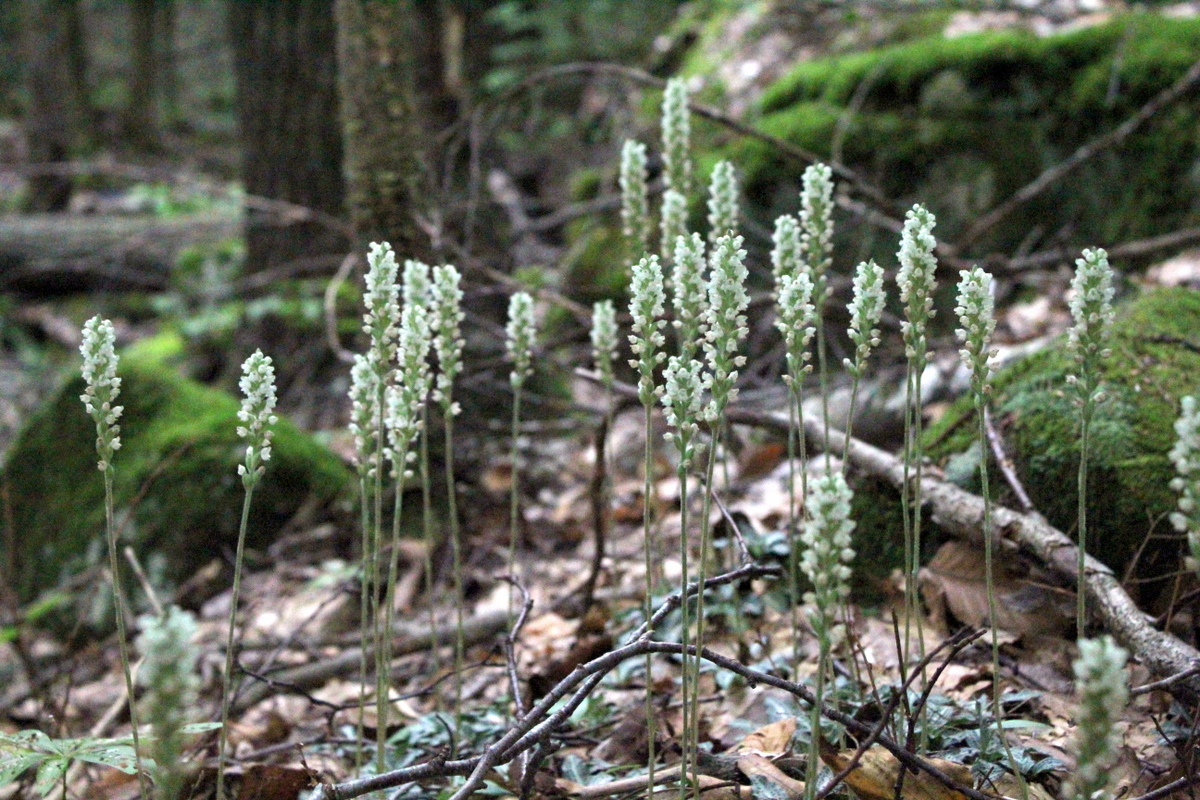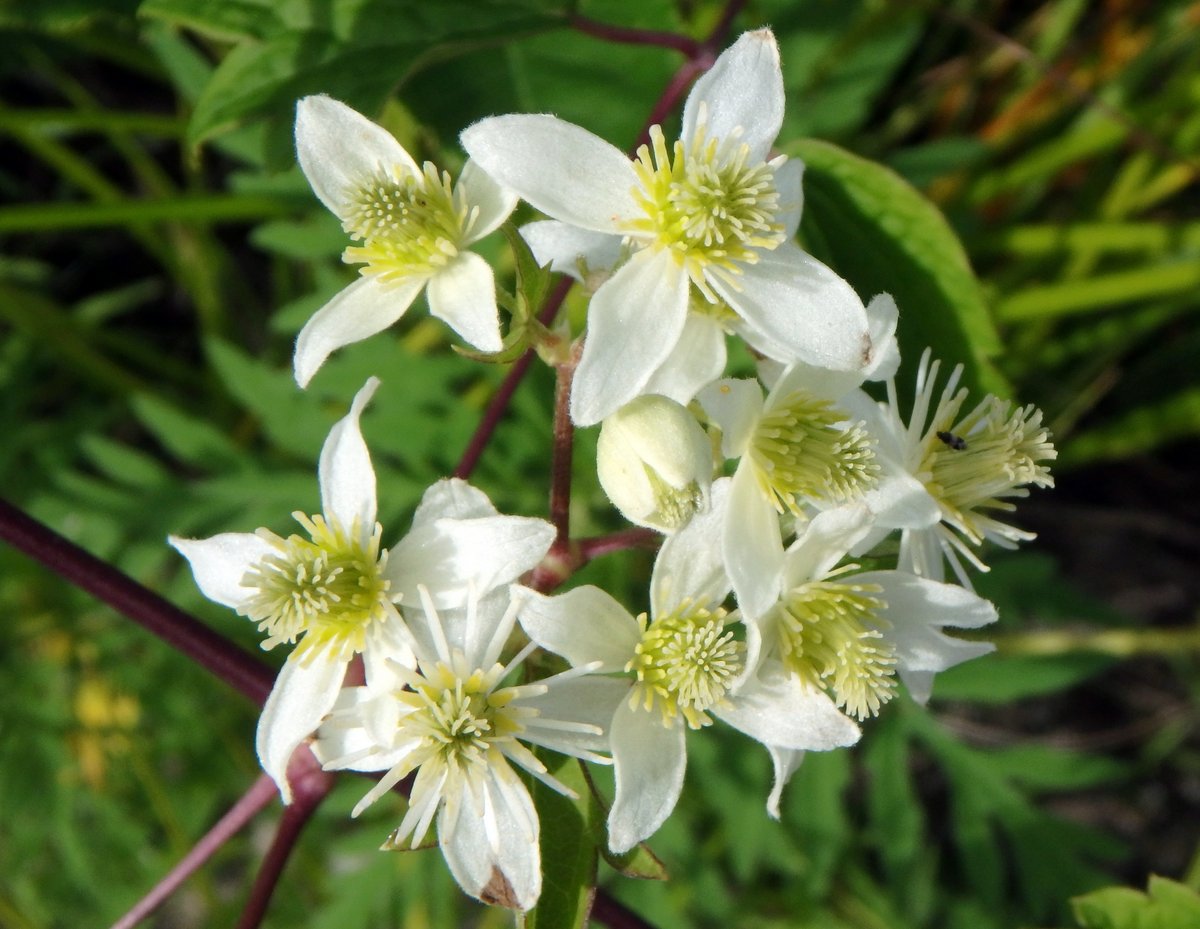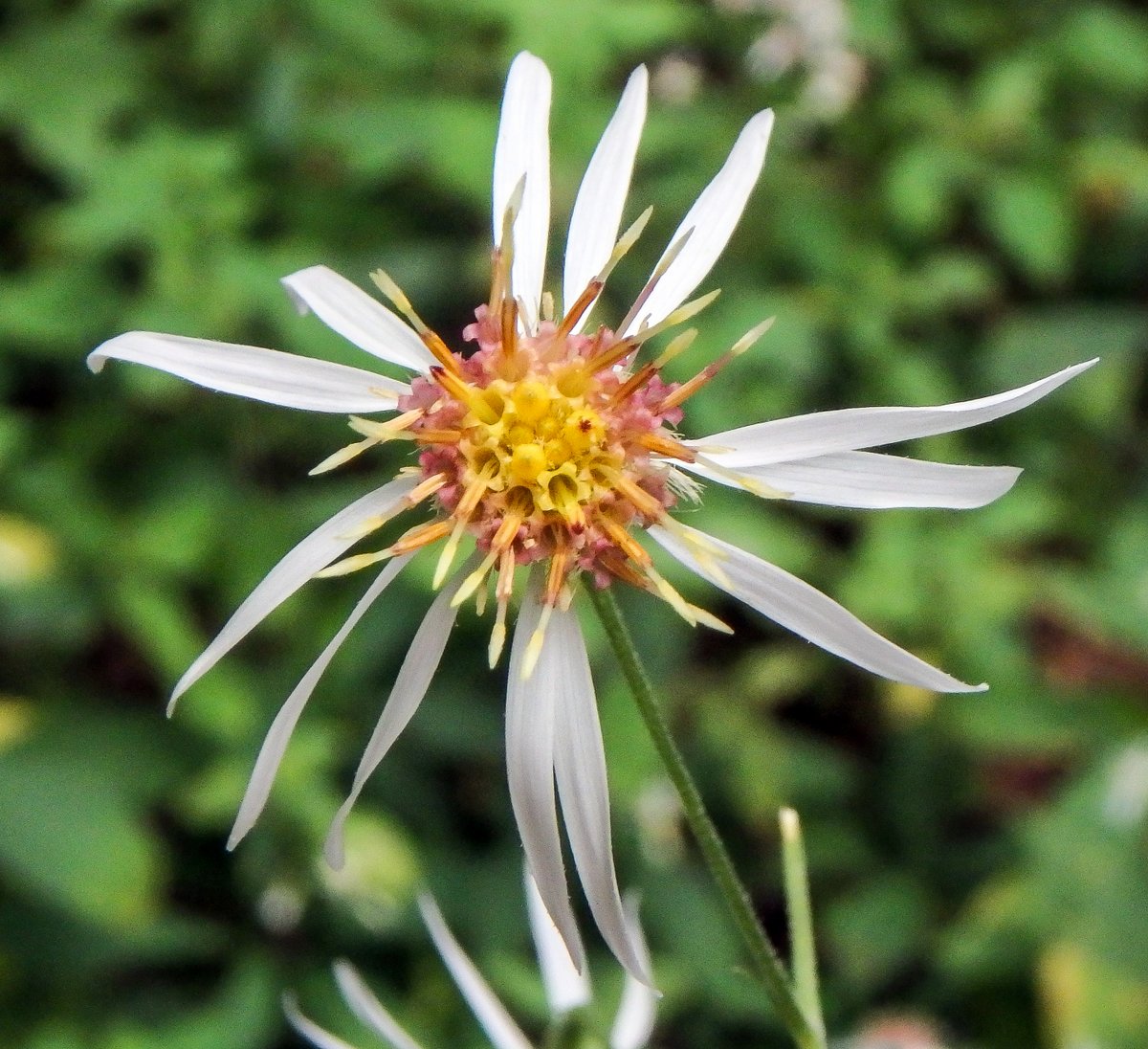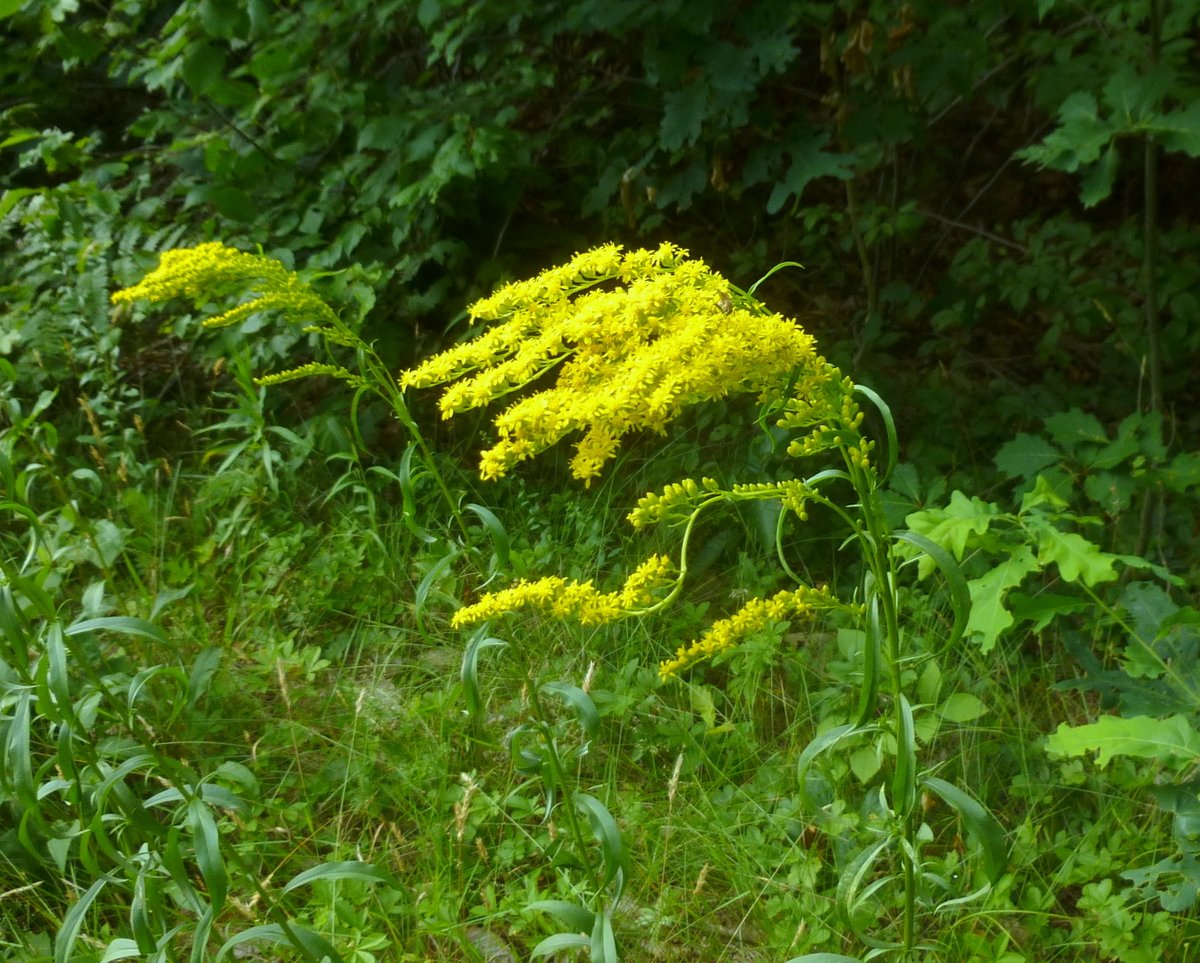
Narrow leaved gentians (Gentiana linearis) grow alongside an old dirt road up in Stoddard, so it takes a bit of effort to see them. It’s always worth it though; gentians of any kind are extremely rare in these parts and I’m always as excited to see them as I would be to see a field full of orchids. They’re such a beautiful shade of blue.

The gentians were coming up through ferns and I’m hoping the ferns aren’t choking them out. Narrow leaf gentians like moist, calcium rich soil and that’s one reason you don’t see them on this blog very often, because our soil is generally acidic. The flowers never really open so insects have to force their way in, and it takes a strong insect like a bumblebee to do so.

I didn’t see a bumblebee on the gentians but I did see one on a Mexican sunflower (Tithonia rotundifolia) I found growing in a local garden. This is another flower that I have never seen here before this and I wonder why more people don’t grow it. It’s a pretty flower but the plants were a bit wilted on the day I saw them, so maybe they need a lot of water? I don’t know them well, so I can’t say. They certainly do attract insects.

I realized that I hadn’t been keeping up with the roses this year so here is a pink one I saw in a local garden.

This one reminded me of the cabbage roses I grew up with. My mother planted them before she died and the fragrance was unbelievable. Sitting out on the porch on a warm summer evening smelling the hedge full of hundreds of fragrant roses is a pleasant memory I’ve carried with me my entire life.

Google lens tells me this is a northern sundrop (Oenothera tetragona.) I’m okay with the sundrop part but northern sundrops have red buds and the buds on this plant were green. This plant is in the evening primrose family and there is a northern evening primrose (Oenothera parviflora) but it has flowers that do not open during the day and this flower was fully open at about 11:00 am. There is a narrow leaved evening primrose (Oenothera fruticosa) with 4-petaled bright yellow flowers which are 2-3 inches across, so that fits. It blooms in April through August in sandy soil along roadsides so that fits as well. Even though I can tick off a few positives there is a big negative, and that is that Oenothera fruticosa is rare in New England. Though it is listed as present in New Hampshire it is also listed as unranked, so in the end all I can tell you is that I found a sundrop plant beside an old dirt road and I can’t tell you its name. It’s very pretty though and there are sundrop cultivars for gardens.

Before the lily beetles came and finished them off, I used to grow Asiatic lilies. I planted them under each window so their wonderful fragrance would fill the house and it did until it didn’t. I grew stargazer lilies which were much pinker than these I found in a local garden. These were a bit over done as far as color I thought, but the fragrance was still heavenly. If you want wonderful fragrance in the garden Asiatic lilies will get you there.

I was looking for sunflowers but instead found these rudbeckia plants in the same garden as the Asiatic lilies. I do enjoy seeing what plant breeders are doing, so I was pleasantly surprised to see them. They’re quite different from any I’ve ever seen.
NOTE: A reader believes this might be a Gaillardia rather than a rudbeckia. Since I don’t know Gaillardia I’ll ask all of you what you think. I based my identification on the leaves, which couldn’t be any more rudbeckia like. But then maybe Gaillardia leaves look like that too. What do you think?

These nodding onions (Allium cernuum) I found in the same garden as the rudbeckia and Asiatic lilies were quite beautiful, I thought. They were dainty little things and I loved their colors. These plants are native to the U.S., with a range from New York to Michigan down to Georgia and the mountains of Arizona.

White wood aster (Aster divaricatus) is known for its drought tolerance and will grow under a heavy leaf canopy. The stalked, coarsely toothed leaves help with identifying this plant. The small, one-inch flowers of white wood asters can have red or yellow centers and they always look a bit wonky, like like a chubby fingered toddler had glued the petals on. This aster is very easy to grow and makes an excellent choice for a dry shaded woodland garden. It is best used in mass plantings, which is how it grows naturally. Where I work, they’ve come up under lilacs and they’re very pretty there, so I just let them be.

In a normal year I would see big leaf asters (Eurybia macrophylla) like those in the above photo blooming before the white wood asters we just saw but this year things are reversed and big leaf asters came in second. The flowers of big leaf aster are about the size of a nickel and are usually white but you can find an occasional plant with purple flowers as I did in this instance.

Big leaf asters get their common name not surprisingly, from their big, hand size leaves. Big leaves gather more light and since this plant grows in forests under trees that is how it has evolved. The leaves on this plant are very different from other asters, so it’s a hard plant to misidentify. I should also say that these leaves are not at all shiny. The only reason they look shiny in this photo is because it was a dewy morning and they were wet. Normally they would have a kind of dull, matte finish.

Bees were loving the purple coneflowers, which are now at their peak of bloom. They’re another native plant, native to the prairies of the mid west.

It’s just about time to say goodbye to our native purple flowering raspberries (Rubus odoratus.) Or at least, the flowers. The fruit comes next of course, and it will look like an oversize raspberry. These 2-inch diameter flowers look like roses at a glance but a closer look at the leaves and stems tells the story.

I wanted you to see the variations in color you can find on a single flowering raspberry plant. The flowers can look quite different even when they grow side by side. I’ve always thought the age of the blossom must have something to do with it but of course I can’t prove it.

Boneset (Eupatorium perfoliatum) has just come into bloom. At a glance you might call it white Joe Pye weed and in fact the two plants are closely related, but the thread like flower styles are really the only shared feature. The leaves look quite different than those found on Joe Pye weed. I find boneset on river, pond and stream banks; almost always near water.

Wild basil (Clinopodium vulgare) is a first for this blog. Though I must have walked by it for years I just noticed it where I work one morning. The silvery looking things that the flowers are growing out of are the spiky flowerheads, covered in dew. The flowers are very small and it took several tries to get a useable photo of them. The plants sprawl a bit but are quite short. I’d have to call them maybe shin high.

I’m not thrilled with this shot of the wild basil flower but the plants have been cut so it’s all I have. The plant is in the mint family and the leaves are edible. They are said to have a minty, peppery taste. I’ve also read that a sweet and aromatic herb tea can be made from the fresh leaves. It is said that the plant probably came from Europe because it is very common there, but nobody seems to know for sure. Since I’ve seen it exactly once in 60+ years I doubt it could be called invasive, even if it did originate in Europe.

As the story goes, once upon a time a lady (with a dirty thumb?) made an impression on this plant and it has been called lady’s thumb (Polygonum persicaria) ever since. Though it doesn’t show very well in this photo, the base of each leaf forms a clasping sheath where it joins the central stem. Clasping leaves and the spots on each leaf are helpful identifiers. This plant is originally from Europe.

The small whitish-pink flowers are hard to find fully open and often aren’t seen when they are open. This is a small, unobtrusive plant that might reach 2 feet tall on a good day.

And there is the lady’s thumb print. Lady’s thumb is very similar to other knotweeds and smartweeds, but is the only one with the brownish black “thumb print.” I found the plant pictured growing in the rocky, sandy soil by a pond. Smartweeds get their name from the way they’ll make your tongue smart if you bite into them. The name knotweed comes from the sheath that encircles the nodes on the stems.
NOTE: A helpful reader has identified this plant as Persicaria extremiorientalis, far-eastern smartweed. Thank you Sara!

Regular readers of this blog know that I believe that all flowers have a divine inner light. In some flowers it’s easy to see and in others it’s not so easy, but one of the flowers that always shows it best is the purple morning glory (Ipomoea purpurea.) I always have to stand in awe of its amazing ethereal light, just for a few moments. If a flower’s inner light can shine so brightly just imagine what yours might do.
Your inner light is what makes you beautiful. ~Mary Davis
Thanks for coming by.



























































































































